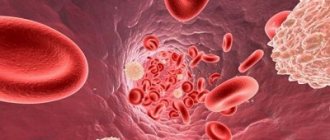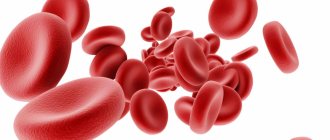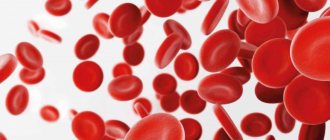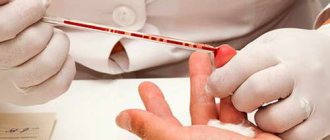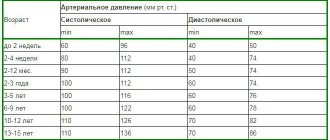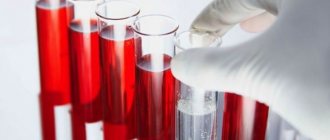Published: 03/30/2021 17:00:00 Updated: 03/30/2021
Erythrocytes are red blood cells, the most numerous blood cells. Formally, they are not cells, since during the process of maturation they lose many of the structures necessary for cells. For example, they lack nuclei and do not synthesize any protein molecules, unlike other cells in the body. So the name “cell” in this case is used for convenience. Red blood cells are formed in the bone marrow and constantly circulate in the body, performing the most important function of maintaining life - they carry oxygen from the lungs to tissues and organs and remove carbon dioxide.
In addition to red blood cells, blood contains plasma, platelets, and leukocytes. However, the number of red blood cells is so large that just a couple of drops of blood contains about one billion of these cells. They make up about 40% of the total blood volume. Actually, it is red blood cells that give our blood its characteristic red color due to its hemoglobin content.
Red blood cells do not last forever, they wear out over time and eventually die. The average life cycle of a red blood cell is approximately 120 days—a total of four months. However, do not worry, the bone marrow is constantly producing new cells and maintaining the required level of red blood cells. Various unfavorable circumstances can reduce or, conversely, increase their reproduction rate and affect their life expectancy - thus, the balance of blood composition is disrupted. An increase or decrease in red blood cells is associated with various pathological conditions. Let's consider this issue in more detail.
Red blood cells are normal
The normal limits vary depending on gender, age and other characteristics.
So, for an adult man it ranges from 4.0 to 5.1 × 10¹² units per liter of blood, and for women - 3.7 to 4.7 × 10¹² per liter.
In pregnant women, red blood cells may decrease to 3–3.5 x 10¹² per liter.
In children under one year of age, the concentration of red blood cells is constantly changing, so to assess the composition of their blood there is a special table that doctors use when interpreting tests.
In childhood, after one year there are still slight deviations from the “adult” norm, but by adolescence the level of red blood cells levels out.
How to read a blood test in children
A complete blood count (CBC) is one of the most common types of laboratory diagnostics, which is an excellent “indicator” of the child’s health status. Diseases and other disorders - all this is immediately reflected in blood counts. That is why, if a child feels unwell, the first thing they do is send him for a blood test.
Blood counts: who is responsible for what?
Red blood cells (RBC) are anucleate red blood cells containing hemoglobin, with which they carry oxygen from the lungs to tissues and CO2 from tissues to the respiratory organs, neutralize some toxins, and regulate blood pH.
An increase in the level of red blood cells (erythrocytosis) occurs with dehydration, increased physical activity, fasting, and increased sweating. A decrease in red blood cells (erythropenia) occurs with blood loss, anemia and chronic inflammation.
Hematocrit (HCT) is the percentage ratio of the number of red blood cells to the volume of the liquid part of the blood.
Hematocrit increases with large fluid loss (frequent vomiting, diarrhea), an increase in the number of red blood cells - erythremia, hypoxia, some genetic diseases, physiological erythrocytosis of newborns, etc. A decrease in hematocrit is observed with a decrease in the number of red blood cells with anemia, hemolytic disease of newborns, hemolysis, hyperproteinemia, etc. .
Would you like to receive a transcript of the analysis?
Sign up
Callback form
Application has been sent, we will contact you soon
Hemoglobin (Hb) is a complex protein containing iron. It is vital for humans, providing oxygen to the body and maintaining acid-base balance. An increase in hemoglobin can be caused by dehydration (vomiting, diarrhea, insufficient fluid intake, burns), absolute erythrocytosis, and some genetic and malignant diseases.
A decrease in hemoglobin per unit volume of blood, often with a simultaneous decrease in the number of red blood cells or their total volume, is anemia, which is a symptom of various pathological conditions, such as chronic kidney disease, hemolysis, chronic infections, bleeding consequences, etc.
Indicators such as MCV, MCH, MCHC (erythrocyte indices) help determine the type of anemia.
Reticulocytes (RTC) are young immature red blood cells, the number of which can be used to judge the rate of blood renewal in the child’s body.
Platelets (PLT) are involved in blood clotting.
A lack of platelets (thrombocytopenia) indicates problems with blood clotting (hereditary diseases or recent bleeding). Their deficiency can also occur with infections, anemia and malignant diseases, and when taking certain medications. If there are more platelets than normal (thrombocytosis), this may indicate a chronic inflammatory disease, recovery from thrombocytopenia, anemia, etc.
ESR (ESR) - erythrocyte sedimentation rate - is a nonspecific indicator that most often increases with inflammation of various etiologies.
An unreasonable increase in ESR in children may indicate an inflammatory process. But a decrease in ESR in newborn babies is almost always a variant of the norm.
blood cells (WBC) are white blood cells that perform a protective function in the body. The main function of leukocytes is to protect the body from bacterial, viral, fungal infections, foreign proteins, foreign bodies that penetrate the blood and tissues, as well as the formation of immunity.
Normally, all leukocytes must be in a precisely defined quantitative ratio, called the leukocyte formula. Changing this formula is a very important clinical indicator.
What is the “leukocyte formula”?
It shows the content of different types of leukocytes in a general blood test.
— Neutrophils are the most numerous type of white blood cells. Their main task is to surround bacteria and destroy the source of infection. These cells come in different types depending on the degree of maturity of the cells: myelocytes, metamyelocytes, band, segmented.
— Eosinophils (EOS) . These cells are responsible for allergic reactions in the body and for the production of immunoglobulins of group E. The number of these leukocytes can increase during allergic reactions, helminthic infestations, and bronchial asthma.
— Basophils (BAS) . Cells with functions similar to eosinophils. Their number indicates the presence of inflammation or allergic reactions in the body.
— Lymphocytes (LYM) . These are the main cells of the human immune system. Provide humoral and cellular immunity. Thanks to them, a recovered or vaccinated child is protected for many years from many dangerous infections.
— Plasma cells are mature B lymphocytes that produce antibodies to fight infections. Their increased content in the child’s blood indicates active immune resistance to viral infection.
— Monocytes (MON) . These cells fight foreign agents and also act as “scavengers.”
A change in the level of leukocytes in a blood test in children (leukocytosis or leukopenia) indicates an infection in the body or a disorder of hematopoiesis. Only a doctor can make an accurate conclusion.
What are the norms for general blood test indicators in children?
| Indicators | Age | ||||||
| 1 day | 1 month | 6 months | 1 year | 1-6 years | 7-12 years | 13-15 years old | |
| Hemoglobin (Hb), g/l | 180-240 | 115-175 | 110-140 | 110-135 | 110-140 | 110-145 | 115-150 |
| Red blood cells (RBC), ×1012 cells/l | 4,3-7,6 | 3,8-5,6 | 3,5-4,8 | 3,6-4,9 | 3,5-4,5 | 3,5-4,7 | 3,6-5,1 |
| Color index (MCHC), % | 0,85-1,15 | 0,85-1,15 | 0,85-1,15 | 0,85-1,15 | 0,8–1,1 | 0,8–1,1 | 0,8–1,1 |
| Reticulocytes (RTC), ppm | 30-51 | 3-15 | 3-15 | 3-15 | 3-12 | 3-12 | 3-12 |
| Platelets (PLT), 109 cells/l | 180-490 | 180-400 | 180-400 | 180-400 | 160-390 | 160-380 | 160-360 |
| Thrombocrit (PST), % | 0,15-0,35 | 0,15-0,35 | 0,15-0,35 | 0,15-0,35 | 0,15-0,35 | 0,15-0,35 | 0,15-0,35 |
| ESR (ESR), mm/hour | 2-4 | 4-8 | 4-10 | 4-12 | 4-12 | 4-12 | 4-15 |
| White blood cells (WBC), 109 cells/l | 8,5-24,5 | 6,5-13,5 | 5,5-12,5 | 6,0-12,0 | 5-12 | 4,5-10 | 4,3-9,5 |
| Band neutrophils, % | 1-17 | 0,5-4 | 0,5-4 | 0,5-4 | 0,5-5 | 0,5-5 | 0,5-6 |
| Segmented neutrophils, % | 45-80 | 15-45 | 15-45 | 15-45 | 25-60 | 35-65 | 40-65 |
| Eosinophils (EOS), % | 0,5-6 | 0,5-7 | 0,5-7 | 0,5-7 | 0,5-7 | 0,5-7 | 0,5-6 |
| Basophils (BAS), % | 0-1 | 0-1 | 0-1 | 0-1 | 0-1 | 0-1 | 0-1 |
| Lymphocytes (LYM),% | 12-36 | 40-76 | 42-74 | 38-72 | 26-60 | 24-54 | 22-50 |
| Monocytes (MON),% | 2-12 | 2-12 | 2-12 | 2-12 | 2-10 | 2-10 | 2-10 |
Get regular check-ups with your pediatrician and get blood tests. And be healthy!
Elevated red blood cells
Red blood cells can be elevated due to many reasons, ranging from banal dehydration to erythremia - chronic leukemia.
Therefore, if there are any deviations in test results, you should consult a specialist to determine the cause. An increase in the number of red blood cells is called erythrocytosis, which can be: 1. Primary. A rare hereditary disease characterized by loss of energy, dizziness and darker color of the mucous membranes. 2. Secondary. Caused by other diseases or conditions (for example, smoking or staying in high mountains) and is associated with oxygen starvation of cells.
Thus, the following reasons for the increase in red blood cells can be identified:
- Dehydration. When the volume of fluid in the body is reduced, the percentage of red blood cells (and other blood cells) artificially increases.
- A lack of oxygen, which the body tries to compensate by producing more red blood cells.
- Congenital heart defect. If the heart cannot pump blood effectively, the amount of oxygen reaching the tissues is reduced. The body creates more red blood cells to compensate for oxygen deprivation.
- Genetic causes (changes in sensitivity to oxygen, impaired release of oxygen by hemoglobin).
- Polycythemia vera is a rare disease in which the body produces too many red blood cells.
Increased production of red blood cells can cause blood to thicken, slow blood flow, and related problems (eg, headaches, dizziness, vision problems, excessive blood clotting).
Often, elevated red blood cell levels are due to dehydration, hot weather, extreme stress, or excessive exercise. A pathological increase in red blood cells is a fairly rare pathology. Much more often, patients encounter reduced levels.
Description of the causes of erythrocytosis
An excess of red blood cells in the blood plasma is called erythrocytosis. As a result, the blood begins to thicken and moves through the capillaries with difficulty. Red blood cell production spontaneously increases in the body when oxygen levels in cells decrease. Lack of oxygen can be caused by congenital pathology of the heart muscle, heart failure, hemoglobinopathy, chronic obstructive pulmonary disease, and excessive smoking.
It is possible to regulate the formation of red blood cells with the help of certain drugs. These include anabolic steroids, erythropoietin protein and some groups of antibiotics intended for the treatment of infectious and inflammatory processes in hematopoiesis.
The consequence of an increase in red blood cells in blood cells can be dehydration, which occurs as a result of an increase in temperature in the body, the occurrence of gag reflexes and loose stools. During such deviations, the concentration of red blood cells increases, but their number does not change.
Decreased red blood cells
The main symptoms of low red blood cell count are:
- Weakness or fatigue.
- Lack of energy.
- Paleness of the skin.
Reduced red blood cells are a relatively common pathology.
A low number of red blood cells and/or hemoglobin is called anemia. If there are few red blood cells, there is correspondingly less hemoglobin in the bloodstream, which carries oxygen. Thus, the body experiences oxygen starvation, and we feel weakness, drowsiness, loss of vitality, and dizziness. Due to anemia, hair falls out, the skin becomes pale and dry. There are many forms of anemia, each with its own cause. Anemia can be temporary or acquired; depending on severity - from mild to severe. According to a 2015 publication in The Lancet, about one-third of the world's population is anemic.
The most common causes of low red blood cells are:
- Unbalanced diet with deficiency of iron, vitamin B12 or folic acid.
- Damage to the bone marrow (toxins, radiation or chemotherapy, infection, certain medications).
- Any bone marrow disease.
- Chronic inflammatory processes.
- Bleeding in the digestive tract (for example, from ulcers, polyps, colon cancer).
- Heavy menstrual bleeding.
- Trauma with massive blood loss.
- Conditions that cause the destruction of red blood cells (for example, hemolytic anemia caused by autoimmune processes or defects in the red blood cells themselves).
- Kidney failure – serious kidney pathologies lead to a decrease in erythropoietin (or hematopoietin), a kidney hormone that promotes the production of red blood cells.
The risk of anemia is higher in the following groups:
- children aged from 6 months to 2 years;
- pregnant or recently given birth women;
- following a diet low in vitamins, minerals and iron, red meat;
- patients who regularly take medications that cause inflammation of the gastric mucosa (for example, ibuprofen);
- having a family history of hereditary anemia such as sickle cell anemia or thalassemia;
- patients with an intestinal disorder that affects the absorption of nutrients (eg, Crohn's disease);
- have recently experienced major blood loss due to surgery or injury;
- people with chronic diseases (HIV, diabetes, kidney disease, cancer, rheumatoid arthritis, heart failure, liver disease).
Deviation from the norm is not always a disease
If the level of red blood cells during the first analysis is slightly outside the normal range, do not panic.
Your doctor will help you interpret the results correctly, taking into account your individual characteristics and medical history. A single slightly elevated or slightly decreased result may have no medical significance. There are several factors that can cause a test result to fall outside the established reference range without pathological reasons:
- Under the influence of external factors (stress, previous infections, physical activity), the results of the analysis of the same person may differ slightly. In this case, a person can be healthy. If the analysis shows a slight deviation, retake the test on another day.
- Individual characteristics. For some people, the boundaries of the norm may differ slightly from generally accepted ones. Reference values are valid for the vast majority of people, but we are all different, and in some rare cases, a healthy person may have their own norms, slightly different from the usual values.
Only a doctor can accurately determine this after conducting additional research.
Tests for red blood cells
A red blood cell count and cell count is usually done as part of a complete blood count (CBC).
A general blood test is the most common analysis, informative for almost any pathological process. This test can also be used to diagnose and/or monitor a number of diseases that affect the production or lifespan of red blood cells. You can take a general blood test with determination of 5 fractions of leukocytes at any CityLab medical center.
For an accurate diagnosis, the doctor may prescribe additional tests:
- Reticulocyte count - determines the number of immature red blood cells.
- Iron test - this trace element plays an important role in the production of red blood cells.
- Vitamin B12 and folic acid levels – these vitamins are also important for red blood cell production.
- A blood test for ferritin reflects iron reserves in the body.
- Serum iron, total iron-binding capacity of blood serum are additional parameters reflecting the process of iron metabolism in the body.
Author:
Baktyshev Alexey Ilyich, General Practitioner (family doctor), Ultrasound Doctor, Chief Physician
When is a general blood test prescribed?
Human blood consists of hundreds of components. For each of them there are certain standards, and it is the general analysis that allows for a basic study of the main blood parameters. The study is carried out for:
- primary diagnosis of a number of diseases (infectious diseases, anemia, malignant neoplasms and other pathologies);
- assessing the effectiveness of treatment;
- general assessment of a person's health status.
A general blood test involves a comprehensive assessment of the patient’s condition, which makes it possible to identify signs of a particular disease or pathological process. The analysis is prescribed to almost all patients who seek specialized medical care. Taking blood from a vein to conduct a general blood test is a fairly simple, but at the same time informative analysis for the doctor. For example, it allows one to suspect that a patient has allergic or infectious diseases. However, it should be remembered that a general blood test alone is not enough to make a final diagnosis, and the doctor may also prescribe other tests. Thus, a general blood test helps the doctor set a narrower direction for a detailed diagnosis.
This is interesting
Human blood is constantly renewed. Every hour in an adult, approximately five billion white blood cells, two billion platelets and one billion red blood cells are destroyed. They are replaced by new, young cells. About 25 grams of blood are completely renewed per day[2].
